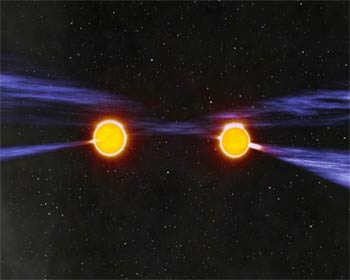Dyson slingshot

Artwork of a binary pulsar such as might prove effective for a Dyson slingshot. Image credit: John Rowe Animation / Australia Telescope National Facility, CSIRO.
A Dyson slingshot is a technique proposed by Freeman Dyson for accelerating a spacecraft to high speeds by using the gravitational field of binary star systems in which the components are collapsed stars. Dyson found that a ship dispatched towards a two-star system with a velocity v where the stars are rotating around each other with velocity V could perform a slingshot maneuver (see gravity assist) and be flung out of the system with a velocity equal to to v + 2V. The final velocity that can be achieved depends critically on the mass and orbital velocity of the paired stars. For example, two white dwarf stars, each with a diameter of 20,000 kilometers and a mass of one solar mass, and with a combined orbital period of 100 seconds, could provide a departure velocity of 0.009c (2,700 kilometers per second). However, two neutron stars, each with a diameter of 20 kilometers and a mass of one solar mass, and with a combined orbital period of 0.005 sec could provide a departure velocity of 0.27c (81,000 kilometers per second).
Reference
1. Dyson, Freeman J. "Gravitational Machines." [Submitted as prize essay to Gravity Foundation, April 1962]. Interstellar Communication, A. G. W. Cameron, Editor, New York: Benjamin Press, 1963, Chapter 12.


